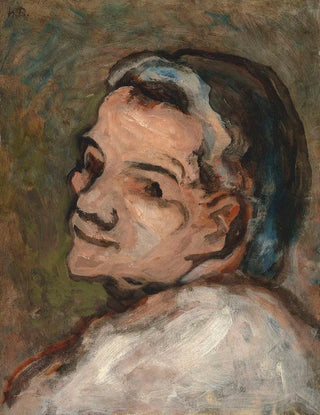Art print | Head of Scapin - Honoré Daumier


View from behind

Frame (optional)
Art print Tête de Scapin - Honoré Daumier – Captivating Introduction
The "Tête de Scapin" by Honoré Daumier is much more than a simple artwork; it is a true window into the human soul, an exploration of emotions that transcends time. This sculpture, which captures the very essence of the character of Scapin, the comic hero of Molière, evokes feelings of cunning and mischief. Through this masterpiece, Daumier invites us to delve into a universe where laughter and reflection intertwine, where every detail of the facial expression tells a story. The power of this work lies in its ability to capture a fleeting emotion, to freeze a moment of life in matter, while leaving a lasting imprint on the viewer's mind.
Style and uniqueness of the work
Honoré Daumier's style is characterized by striking realism, an approach that does not merely reproduce the surface of things but reveals their depth. In the "Tête de Scapin," this singularity manifests through expressive features, accentuated contours, and particular attention to detail. The sculpture exudes palpable energy, a liveliness that echoes the personality of the character it represents. The way Daumier plays with shadows and light gives the piece an almost theatrical dimension, reinforcing the idea that art is a mirror of life. Every line, every curve is designed to evoke a reaction, a connection with the audience, thus making the work timeless.
The artist and his influence
Honoré Daumier, an emblematic figure of the 19th century, knew how to mark his era with prolific and committed work. An artist of many talents, he navigated between painting, sculpture, and caricature, using his art as a tool for social critique. His interest in the human condition and societal flaws is reflected in each of his creations. The "Tête de Scapin" is the result of this sharp observation of human nature, a tribute to the comedy and tragedy that coexist in our daily lives. Daumier's influence extends far beyond his time, inspiring many contemporary artists who see in him a

Matte finish

View from behind

Frame (optional)
Art print Tête de Scapin - Honoré Daumier – Captivating Introduction
The "Tête de Scapin" by Honoré Daumier is much more than a simple artwork; it is a true window into the human soul, an exploration of emotions that transcends time. This sculpture, which captures the very essence of the character of Scapin, the comic hero of Molière, evokes feelings of cunning and mischief. Through this masterpiece, Daumier invites us to delve into a universe where laughter and reflection intertwine, where every detail of the facial expression tells a story. The power of this work lies in its ability to capture a fleeting emotion, to freeze a moment of life in matter, while leaving a lasting imprint on the viewer's mind.
Style and uniqueness of the work
Honoré Daumier's style is characterized by striking realism, an approach that does not merely reproduce the surface of things but reveals their depth. In the "Tête de Scapin," this singularity manifests through expressive features, accentuated contours, and particular attention to detail. The sculpture exudes palpable energy, a liveliness that echoes the personality of the character it represents. The way Daumier plays with shadows and light gives the piece an almost theatrical dimension, reinforcing the idea that art is a mirror of life. Every line, every curve is designed to evoke a reaction, a connection with the audience, thus making the work timeless.
The artist and his influence
Honoré Daumier, an emblematic figure of the 19th century, knew how to mark his era with prolific and committed work. An artist of many talents, he navigated between painting, sculpture, and caricature, using his art as a tool for social critique. His interest in the human condition and societal flaws is reflected in each of his creations. The "Tête de Scapin" is the result of this sharp observation of human nature, a tribute to the comedy and tragedy that coexist in our daily lives. Daumier's influence extends far beyond his time, inspiring many contemporary artists who see in him a






